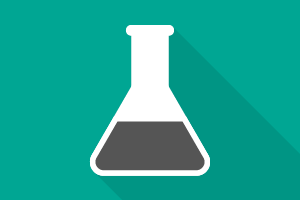Classroom Resources: Reactions & Stoichiometry
Filter by:
126 – 150 of 192 Classroom Resources
-

Classification of Reactions | High School
Lesson Plan: Geometric Equations Challenge
In this lesson plan, students find patterns in the reactions between several geometric shapes and then learn about the five main types of reactions.
-

Conservation of Mass, Renewable Energy | High School
Lab: Soap or Fuel?
In this lab, students will transform vegetable oil into a soft soap and into biodiesel fuel. The two reactions emphasize that the products of a chemical reaction are under the control of the chemist. By noting the relationship of the reaction product to the reactants, students will gain a deeper understanding of the law of conservation of matter.
-

Balancing Equations | High School, Middle School
Activity: Snowman Challenge
In this activity, students practice completing and balancing chemical equations with a partner.
-

Balancing Equations, Limiting Reactant | High School
Activity: S'more Stoichiometry
In this activity, students determine the number of graham crackers and chocolate pieces required to complete a “reaction” with a given quantity of marshmallows (the limiting reactant). They then use the same thought process with a problem involving a real chemical reaction.
-

Reaction Rate, Chemical Change, Reaction Rate, Observations | Middle School, Elementary School, High School
Demonstration: Simple Kinetics
In this demonstration, students will see that different food dyes react with bleach at different rates.
-

Reduction, Classification of Reactions, Organic Chemistry | High School
Lab: Silver Test Tube Holiday Ornament
In this lab, students will carry out a reduction reaction in order to create a silver-plated test tube that can be used as a holiday ornament.
-

Acid Rain, Acid Base Reactions, Chemical Change | High School
Lab: Seeing the Effects of Acid Rain
In this lesson, students will prepare an environment and make acid rain to see how the acid rain effects the items in the environment.
-

Density, Observations, Chemical Change, Lab Safety, Combustion | High School
Demonstration: Fish Tank Carbon Dioxide
In this demonstration, students watch as a reaction between baking soda and vinegar produces carbon dioxide, which then causes lit candles to extinguish.
-

Chemical Change, Limiting Reactant, Classification of Reactions, Percent Yield, Stoichiometry, Concentration, Molarity, Mole Concept, Dimensional Analysis | High School
Demonstration: First Day Review
In this demonstration, students see evidence of a chemical reaction.
-

Chemical Change, Density, Chemical Change, Density | Elementary School, Middle School, High School
Demonstration: Fire Extinguisher
In this demonstration, students will observe a chemical reaction, and see how the product can be used to extinguish a fire.
-

Chemical Change, Pressure, Reaction Rate, Acid Base Reactions, Chemical Change, Conservation of Matter | Elementary School, Middle School
Lab: Rocket Challenge
In this lab, students will have the opportunity to construct a rocket, with the challenges of both designing it and preparing a chemical reaction for its “fuel” in order to propel the rocket over the furthest distance. Students will investigate available materials, quantities and ratios during allotted planning and testing phases. Student will record their plans, modifications and designs during the process. The lab will culminate with a competition amongst students to see whose rocket will travel the longest distance.
-

Molecular Formula, Stoichiometry | High School
Lab: Finding the Formula of Magnesium Oxide
In this lab, students will recognize that oxygen has mass and that heating can involve and increase in mass as an element reacts to become an oxide
-

Percent Yield, Redox Reaction | High School
Lab: Reduction of Metal Oxides Using Carbon
In this lab, students reduce metal ores using an alternative apparatus to a traditional crucible.
-

Limiting Reactant, Concentration, Net Ionic Equation, Stoichiometry, Balancing Equations, Precipitate, Mole Concept, Dimensional Analysis | High School
Lab: Finding CO2 Mass in your Breath
In this lab, students will measure how much carbon dioxide they exhale by reacting their exhaled breath with lime water (calcium hydroxide).
-

Combustion, Heat of Combustion | High School
Lesson Plan: Redesigning a Car for the Environment
Chemland’s city public transportation board has requested the class to help them determine the direction the city should move towards in reducing the carbon footprint. Students will be divided into groups and will come up with proposals of how to reduce the carbon footprint from carbon dioxide released from vehicles. The groups will represent different ways to reduce the carbon footprint via an alternative fuel source or a new technology. They will debate their findings to determine the direction that the city council should move towards to reduce the carbon footprint.
-

Chemical Change, Classification of Reactions | High School
Lab: Recycling Copper: Understanding Chemical Reactions
In this lab, students will demonstrate their understanding of writing, balancing, translating, and identifying types of chemical reactions. While doing so, they will learn about the process of recycling copper.
-

Classification of Reactions, Oxidation, Reduction | High School
Lab: Extracting Copper From Ore
In this lab, students extract copper from copper carbonate using two different methods, and then determine which industrial method is most effective.
-

Conservation of Mass | High School
Lab: Reactions of Copper
In this lab, students will convert copper metal into different copper compounds and then back to copper to illustrate conservation of matter.
-

Chemical Change, Activity Series, Redox Reaction | High School
Lesson Plan: Exploring Automotive Corrosion
In this lesson students will investigate the galvanic corrosion that can occur when different metals come in contact with each other in modern cars.
-

Classification of Reactions | High School
Lab: Exploding Pumpkin
In this lab, students use a chemical reaction to create an explosion inside of a pumpkin.
-

Heat of Combustion, Combustion, Heat, Temperature, Calorimetry, Specific Heat, Enthalpy, Bond Energy, Scientific Method, Experimental design, Graphing, Accuracy, Error analysis | High School
Activity: Evaluating Fuels
In this activity, students measure the heats of combustion of four fuels and compare them as potential replacements for gasoline.
-

Chemical Change, Conservation of Matter, Identifying an Unknown, Culminating Project, Elements | Middle School
Lab: Priestley Labs
In this lab, students will identify an unknown gas based on experimental evidence.
-

Chemical Change, Density, Classification of Reactions | High School
Demonstration: Preparation of Hydrogen
In this demo, students witness a single displacement reaction between zinc and sulfuric acid that produces hydrogen gas. The gas is collected via water displacement and ignited.
-

Precipitate, Chemistry Basics, Solubility Rules, Balancing Equations, Chemical Change, Chemical Change | High School, Middle School
Lab: Predicting Precipitates
In this lab, students use solubility rules to predict which chemical reactions will produce precipitates.
-

Renewable Energy, Conservation of Mass, Chemical Change, Volume, Pressure | Middle School, High School
Lab: Power That Stinks
In this lab, students will experiment with creating and capturing biogas, and have an opportunity to look at how energy is created from waste. They will explore the differences between non-renewable and renewable energy sources.